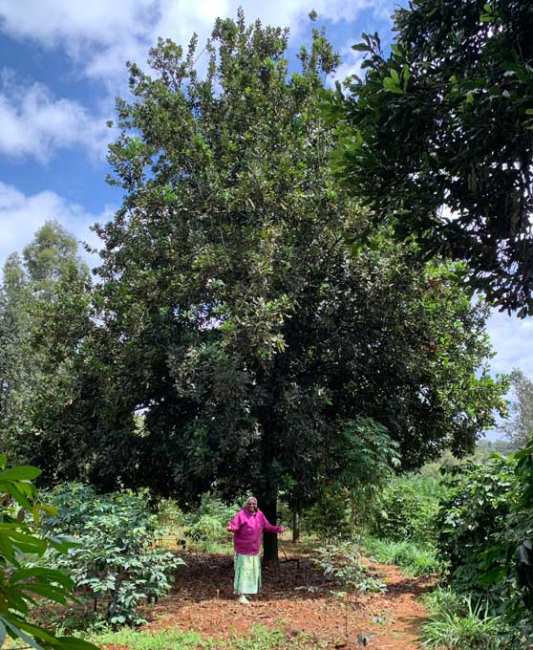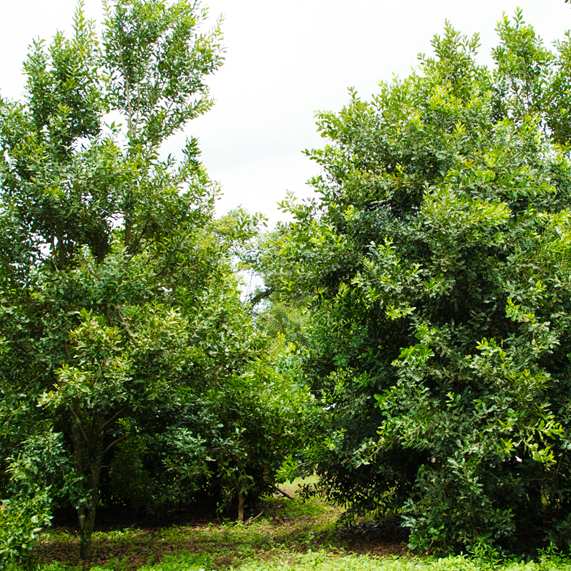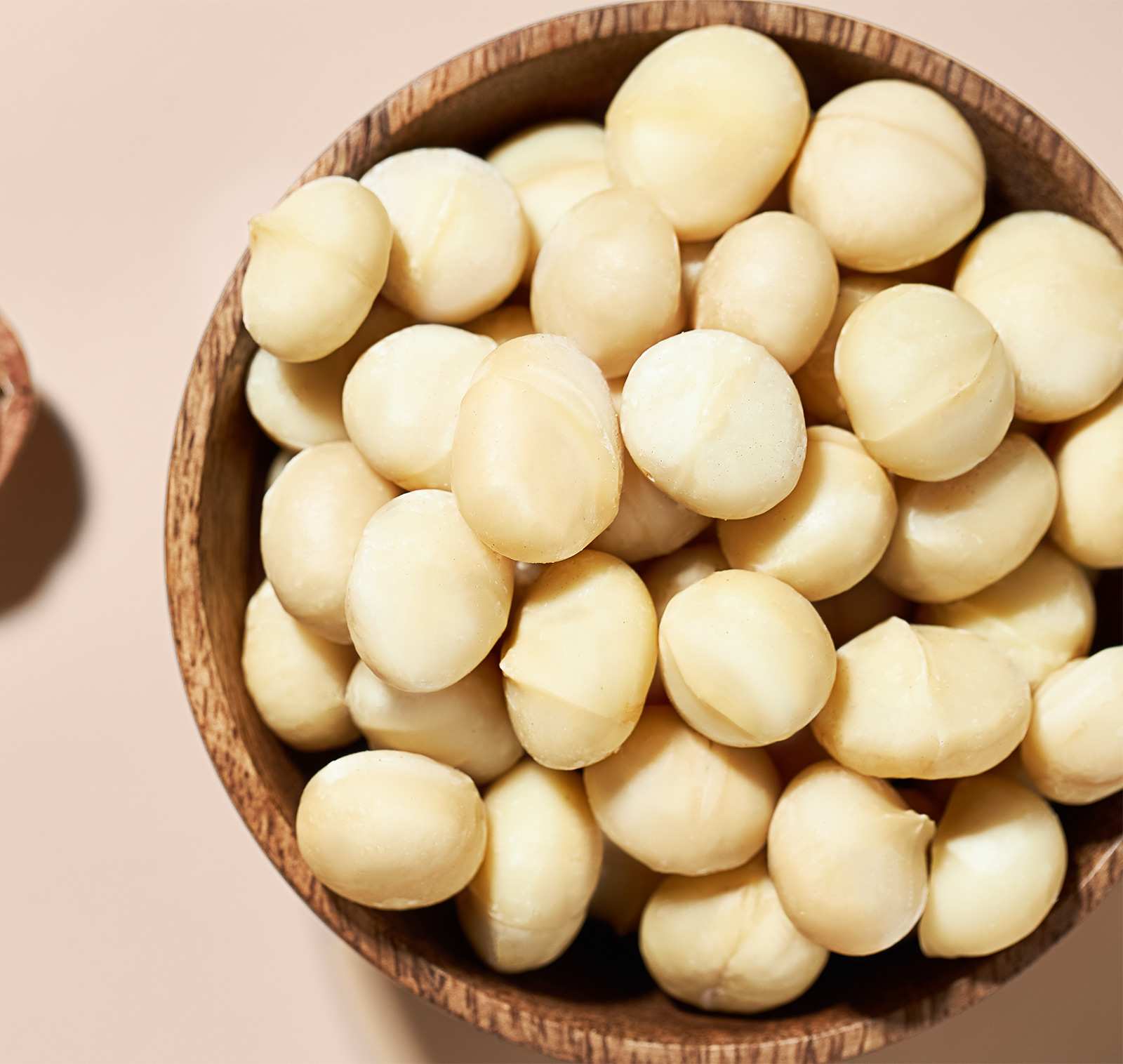
What do Macadamia nuts look like
Hidden treasure: At first glance, the nuts almost look like limes. This is because they are covered by a green protective skin - the outer shell. Underneath, the inner brown shell is revealed. Only when this has been cracked does the actual kernel reveal itself: the macadamia nut.
At LIMBUA, only the high-quality macadamia species Integrifolia is cultivated. These grow on an organic macadamia tree.
The smallholders remove the green shells on their farms and use them as animal feed, fertilizer or compost. The inner, brown shell, however, is about three millimeters thick and extremely hard. To open it gently, we have developed our own handcracking technologies.
This allows us to crack the nuts directly in our on-site factories, one by one and without damaging the precious kernel. The remaining outer shells contribute to soil fertility as mulch or replace valuable wood in the oven - which we take advantage of in the nut drying process.

Image 1: Organic Macadamia nuts in a green protective skin. The brown, thick shell is hidden underneath.

Image 2: The macadamia nut after cracking the brown shell in LIMBUA production.
The Macadamia Tree
How do Macadamia Nuts grow
Macadamia nuts grow on remarkable trees: these reach heights of 15 to 20 metres and develop long, thick leaves. This makes them both a source of shade and protection against evaporation. Their roots, in turn, retain water and prevent erosion – a benefit for the entire ecosystem. Macadamia trees prefer a warm, humid climate with well-drained soil.
At LIMBUA, macadamia trees grow on the smallholders’ farms exclusively in organic mixed cultivation. Among the macadamia trees, other crops such as avocado and mango trees are also grown. This is particularly beneficial for soil fertility.
It takes around 4 - 5 years until the first harvest. A mature macadamia tree yields on average 50 to 80 kg of nuts. On average, contract farmers have 20 mature macadamia trees, which for many serve as a so-called cash crop, providing an important source of income.
The flowering season of macadamia trees in Kenya falls between July and September. After pollination, small green fruits begin to develop. Over the following six to eight months, they ripen slowly, protected by a firm green husk. Only when this splits open in the following year is the right time for harvest.
Each flower raceme can bloom for 4–6 weeks, but the overall flowering season extends over several weeks, depending on the weather. After successful pollination, it takes 6–8 months for the nuts to fully mature.


Can Macadamias grow in Europe?
The macadamia tree thrives in a tropical climate with stable temperatures between 15°C and 25°C. Across most parts of Europe, permanent outdoor cultivation is not possible because the tree is highly sensitive to frost. For those who still want to experiment, young trees can be grown in containers and moved indoors during winter – similar to how citrus plants are managed.
At LIMBUA, macadamia trees grow under ideal natural conditions on the slopes of Mount Kenya. The elevation between 1,200 and 1,800 meters, mild year-round temperatures, and consistent rainfall create a uniquely stable microclimate. In this environment, macadamia trees can reach up to 20 meters in height and start producing nuts regularly from around year 5 to 7.
Growing Macadamia at home or in a greenhouse
A macadamia tree can also be grown in Europe as a potted plant indoors or in a winter garden. What it needs most is a bright location and consistent warmth – ideally temperatures around 20°C.
Water regularly but avoid waterlogging. During the winter months, the plant enters a resting phase and needs less water. With patience, you may see the first blossoms and fruits after a few years – however, the harvest indoors usually remains more symbolic than substantial.

LIMBUA smallholder farmer with an approximately 50-year-old macadamia tree in Kenya
From seedling to Macadamia Tree:

1 Macadamia soaking
Macadamia nuts in shell (seeds) are soaked in water to soften the shell and break dormancy. Immediately after soaking, they are exposed to the sun to promote cracking. The macadamia are then placed on the bed and covered with sand.

2 Germination
After 21 days the first seeds germinate. They do not germinate uniformly, because the dormancy of each seed is different, so it takes up to 75 days to complete the germination process. Within this period, the already germinated seedlings are transplanted once a week.

3 Growth phase
After germination, the macadamia tree seedlings remain in the bed until they are about 10-15 cm tall. Around this time, the tender seedlings have a well-developed root and leaf system. The seedling is carefully pulled out of the sand to take the core, which continues to provide it with nutrients.

4 Planting
The seedlings are planted by drilling a small hole in the center of each tube and carefully inserting the tender seedling together with its core and immediately watered to cool the soil. They remain in the nursery for about 5-7 months before grafting.

5 Grafting
After transplanting, the rootstock needs 5-7 months until it is ready for grafting. When grafting the Macdamia tree, 2 plants are joined together until they are fused - in principle, it is a transplantation of one part of the plant to another. In this way we have developed particularly high-yielding macadamia trees.

6 Traceability
At our nursery, we have implemented a traceability system that helps us track each seedling closely from germination to delivery to our smallholder farmers. This helps us determine various factors that affect the seedlings at each stage of growth.

7 Pre-hardening
After the seedlings are successfully germinated after grafting, they are placed in the pre-hardening - this stage lasts 2 months. Growth and reaction to grafting are carefully monitored at this stage.

8 Delivery
After the grafted seedlings are fully hardened, they are distributed to the smallholders. It takes 4 to 5 years for an organic macadamia tree to bear fruit. As the tree matures, production increases until it reaches its optimum at around 10 years.

9 Mature trees
The macadamia tree can grow up to 20 meters high and 8 meters wide. It not only provides one of the most nutritious nuts, but also the livelihood for many people in rural Africa.
We offer grafted macadamia seedlings ready for planting. You can pick them up in Embu or choose shipping within Africa.
Origin of the Macadamia nuts
The macadamia nut originally comes from Australia, particularly from the areas around Queensland and New South Wales. In the 1850s, the plant was scientifically described for the first time and named after the Scottish chemist John Macadam. Since then, the macadamia has spread worldwide, with countries such as South Africa, the United States and Brazil also having large growing areas today.
Kenya also offers ideal growing conditions for macadamia nuts, characterized by fertile soils, mild climate and sufficient rainfall. The LIMBUA growing areas are located in the central highlands at the foot of Mount Kenya and provide perfect conditions for the growth of macadamia trees.

Macadamia Integrifolia or Tetraphylla?
Why LIMBUA exclusively processes Integrifolia nuts
The Macadamia integrifolia variety differs in several ways from the more common Macadamia tetraphylla: it contains more valuable oils and has a lower sugar content. In addition, it delivers higher yields, which makes organic cultivation more efficient and ensures smallholder farmers in Kenya a sustainable income.
Another key advantage of Integrifolia lies in the roasting result: Tetraphylla nuts become significantly darker when roasted due to their higher sugar content, resulting in a visually inhomogeneous product. For this reason, Tetraphylla nuts are not accepted by reputable customers and packers.
Macadamia integrifolia originates from the subtropical rainforests of Australia and is one of the few commercially cultivated macadamia species worldwide. Its cultivated varieties are particularly well adapted to the conditions of the Kenyan highlands.
In terms of taste, the varieties also differ: Macadamia integrifolia offers a milder, buttery flavor with a fine texture, whereas Tetraphylla often tastes more robust and is somewhat drier and firmer in bite.
Visually, the two varieties can be easily distinguished: Tetraphylla has a rougher and thicker shell, which makes processing more difficult. The Integrifolia macadamia nut, on the other hand, is easily recognizable by its thinner, smoother shell. In addition, the tiger pattern on the smooth brown shell of Integrifolia is a clear indicator of this variety.

Top: Macadamia integrifolia with a smooth shell – the variety processed by LIMBUA.
Bottom: For comparison, the rougher Tetraphylla.
How our macadamia nuts are grown
LIMBUA works exclusively with Kenyan smallholder farmers at the base of Mount Kenya - a particularly fertile region, due to its local climate and volcanic soils that produces high-quality harvests. Careful cultivation also contributes to this. From the beginning this is done in organic farming.
Many farmers have only switched to organic farming through their cooperation with LIMBUA. Knowledge about the dangers of chemical pesticides has not been widely spread before. In addition to organic cultivation, mixed cultivation plays an important role: amongst many other plant species, avocado trees grow between the macadamia tree. This preserves the fertility of the soil - and thus the livelihood of the farmers. In addition, mixed farms produce higher yields and contribute to a healthy ecosystem overall.
Abundant harvests mean a secure source of income for our smallholder farmers. That is why LIMBUA - together with leading scientists - has developed particularly high-yielding macadamia seedlings. These grow in our Kenyan nurseries and are then given to the smallholders. More than 200,000 of these organic seedlings are now thriving on the mixed farms.
In addition, we offer our project partners regular training courses. Here, local agricultural engineers impart valuable knowledge on the topics of cultivation, harvesting and processing. With success: the training increases the quality and quantity of the harvested macadamia nuts year on year.


How healthy is the macadamia nut?
The macadamia is considered one of the healthiest nuts in the world – and for good reason! It is rich in unsaturated fatty acids, contains dietary fibre, and stands out with a wide range of vitamins, minerals, and trace elements. These include, for example:
selenium, magnesium, calcium, iron, zinc, potassium, phosphorus, and B vitamins.
With its nutrient profile, the macadamia nut may help support digestion, contribute to a normal metabolism, and help maintain healthy muscles and nerves. In short: it’s a valuable addition to any diet and is therefore also recommended by nutritionists.
With its favourable ratio of omega-3 to omega-6 fatty acids, along with its vitamins and phytonutrients, the macadamia can have anti-inflammatory effects.
Conclusion: Macadamias are rich in “good fats,” low in carbohydrates, nutrient-dense, and can help reduce inflammation.

Healthy fats – it’s all about the balance
Macadamias have the highest content of monounsaturated fatty acids (MUFAs) of all nuts, in the form of omega-9 and omega-7. Omega-9 is known for potentially helping to reduce inflammation, supporting heart function, and promoting overall well-being. For the rarer omega-7, new research suggests possible links to lower blood sugar levels and healthier insulin responses.
Macadamia nuts also contain polyunsaturated fatty acids (PUFAs) in the form of omega-3 and omega-6. Both are essential for the human body, but most people consume too much omega-6 – for example through processed foods. Excess omega-6 fatty acids, as well as a high intake of saturated fats (found in products such as meat), may contribute to inflammation.
The omega-6 to omega-3 ratio of 6:1 in macadamia nuts can offer a balanced proportion that may support optimal health.
Low in carbohydrates
The low carbohydrate content of macadamias, combined with their high proportion of unsaturated fatty acids, means they are unlikely to cause a spike in blood sugar levels.
This makes them a potentially ideal snack: after consumption, blood sugar tends to rise only minimally, as the lower insulin release during digestion can help maintain a balanced insulin response. This is particularly relevant for people following a LCHF (Low-Carb, High-Fat) diet or managing diabetes.

What do macadamia nuts taste like?
With around 75% fat, macadamia nuts have a wonderfully buttery flavour and a delicate texture that almost melts in your mouth. Slightly sweet and mild, their taste is unlike any other nut and has a hint of vanilla. This is probably why they are often enjoyed on their own – whether roasted and salted or completely raw, they are a treat either way. They also add a special touch to a variety of sweet dishes and baked goods. When pressed into oil, they enhance both hot and cold dishes.
Macadamia oil is also used in cosmetic products – for example, to help keep skin and hair soft and smooth.

Originally, the macadamia comes from Australia. Today it is also grown in Kenya, South Africa, and Hawaii; LIMBUA cultivates it sustainably in the central highlands of Kenya.
Macadamia trees grow up to 20 metres tall, have dense canopies, and thrive in warm, humid climates with well-drained soils.
LIMBUA’s contract farmers cultivate their macadamia trees in the Kirinyaga region at the slopes of Mount Kenya – one of the world’s best growing areas. The elevation of around 1,200 – 1,800 meters, mild temperatures, and consistent rainfall create ideal conditions for healthy tree growth and premium nut quality.
By using mixed cropping systems with trees such as avocado and mango, the farmers further enhance biodiversity and promote a balanced, sustainable ecosystem.
Macadamia trees start bearing fruit from the 4th to 5th year after planting.
A fully mature macadamia tree yields an average of 50 to 80 kg.
Macadamia trees can live 60 to 80 years.
The main harvest season is between February and May, with an off-season between September and November.
The most well-known in commercial use are the Integrifolia and Tetraphylla varieties. LIMBUA processes only Integrifolia, which offers a mild flavour, lower sugar content, and better roasting results.
Macadamia nuts are a natural source of unsaturated fatty acids, fibre, and minerals such as magnesium. As part of a balanced diet, they can contribute to a healthy lifestyle.
"My greatest motivation is that our smallholders, stakeholders and customers who visit our nursery appreciate the products and services I offer them."

CONCLUSION: PERHAPS THE HEALTHIEST NUT FROM SUSTAINABLE & FAIR PRODUCTION

